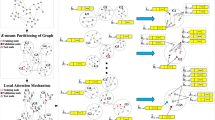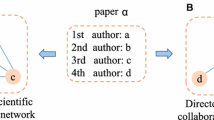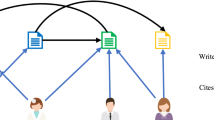Abstract
Scientific talents are the cornerstone of science and technology development. The current method to find out the scientific talent is almost based on the scientists’ achievement, less considering the interrelationships hidden in the objects. In this paper, we propose a centrality-adjusted graph attention network to discover active scientific talents. This graph network can find out the internal correlation among scientific papers by using a predicate-based attention mechanism and in-degree adjustment strategy on the node. We adopt two training ways for experimentation and validation of the proposed model: in-domain and out-of-domain estimation. The experiment result shows that our model performs better than existing models on the Database of Chinese Science Citation on Normalized Discounted Cumulative Gain (NDCG) metrics.



Similar content being viewed by others
References
Arney C 2012 Networks: An Introduction[J]. Mathematics & Computer Education 46
Brin S (1998) The PageRank citation ranking: bringing order to the web[J]. Proc ASIS 1998(98):161–172
Chengwei Gu (2015) Analysis of local policies for introducing overseas scientific and technological talents in China in the new era[J]. Sci Res Manag 36(S1):272–278
Li Chong, Wang Yuchen, Du Weijing, He Xiaotao, Liu Xuemin, Zhang Shipo, Li Shuren 2021 Web of Science-based PageRank talent mining algorithm [J/OL]. Computer Applications:1–7 04–29 http://kns.cnki.net/kcms/detail/51.1307.TP.20201209.1623.020.html.
Ester M, Kriegel H P, Sander J, et al 1996 A density-based algorithm for discovering clusters in large spatial databases with noise [C]. //Kdd 96 34 226 231
Gardner MW, Dorling SR (1998) Artificial neural networks (the multilayer perceptron)-a review of applications in the atmospheric sciences[J]. Atmos Environ 32(14–15):2627–2636
Gharebagh SS, Rostami P, Neshati M 2018 T-shaped mining: a novel approach to talent finding for agile software teams[C]//European conference on information retrieval. Springer, Cham 411–423.
Grover A, Leskovec J 2016 node2vec: Scalable feature learning for networks[C]//Proceedings of the 22nd ACM SIGKDD international conference on knowledge discovery and data mining 855–864
Jantan H, Hamdan AR, Othman ZA (2009) Potential data mining classification techniques for academic talent forecasting. Ninth Int Conf Int Syst Des Appl 2009:1173–1178
Ling F, Expo X, Bin L (2019) A multilayer perceptron-based talent discovery method for technological innovation[J]. Comput Appl Softw 36(07):26–31
Michael 2009 DBLP: some lessons learned[J]
Moreira C 2011 Learning to rank academic experts [D]. Instituto Superior Tecnico 30–49
Moreira C, Calado P, Martins B (2015) Learning to rank academic experts in the DBLP dataset[J]. Expert Syst 32(4):477–493
Osisanwo FY, Akinsola JET, Awodele O et al (2017) Supervised machine learning algorithms: classification and comparison[J]. Int J Comput Trends Technol 48(3):128–138
Park N, Kan A, Dong X L, et al 2019 Estimating node importance in knowledge graphs using graph neural networks[C]//Proceedings of the 25th ACM SIGKDD International Conference on Knowledge Discovery & Data Mining 596 606
J Ren, Wang L, Wang K, et al 2019 API an index for quantifying a scholar’s academic potential[J] IEEE Access 7 178675 178684
Ruixia X, Xiuxia Li (2019) Author influence evaluation index based on co-authorship network[J]. Int Theory Pract 42(01):100–104
Shi C, Xu C, Yang X (2009) Study of TFIDF algorithm[J]. J Comput Appl 29(6):167–170
Vaswani A, Shazeer N, Parmar N, et al 2017 Attention is all you need[J]. arXiv preprint 1–4
Veličković P, Cucurull G, Casanova A, et al. Graph attention networks[J]. arXiv preprint 2017: 1–5
Wu Y, Sun Y, Zhuang F et al 2020 Meta-path hierarchical heterogeneous graph convolution network for high potential scholar recognition[C]// 2020 IEEE International Conference on Data Mining (ICDM). IEEE
Yanping J, Wanjun X, Yingmei Z, Xiaohong C (2019) A study on the discovery and evaluation strategy of global potential Chinese young scholars based on bibliometric method[J]. J Intelligence 38(07):178–183
Ye Y, Zhu H, Xu T, et al 2019 Identifying high potential talent: a neural network based dynamic social profiling approach[C]//2019 IEEE International Conference on Data Mining (ICDM). IEEE 718–727.
Yilmaz E, Kanoulas E, Aslam JA 2008 A simple and efficient sampling method for estimating AP and NDCG[C]//Proceedings of the 31st annual international ACM SIGIR conference on Research and development in information retrieval 603 610
Zhao, Ning, Guohui Yang, and Yang Cao 2020 Mining technological innovation talents based on patent index using t-SNE algorithms*: take the field of intelligent robot as an example. 2020 IEEE International Conference on Artificial Intelligence and Computer Applications (ICAICA). IEEE 595–601.
Author information
Authors and Affiliations
Corresponding author
Additional information
Publisher's note
Springer Nature remains neutral with regard to jurisdictional claims in published maps and institutional affiliations.
Rights and permissions
About this article
Cite this article
Li, C., Zhang, J., Wang, Y. et al. CAGAT: centrality-adjusted graph attention network for active scientific talent discovery. Pers Ubiquit Comput 26, 177–184 (2022). https://doi.org/10.1007/s00779-021-01659-5
Received:
Accepted:
Published:
Issue Date:
DOI: https://doi.org/10.1007/s00779-021-01659-5




